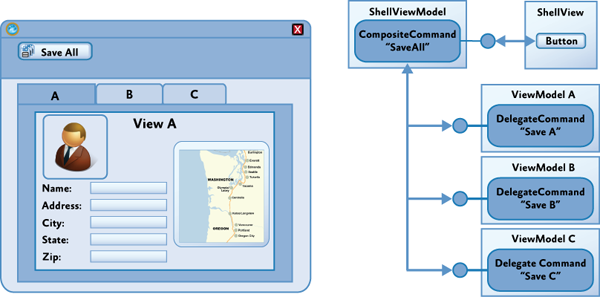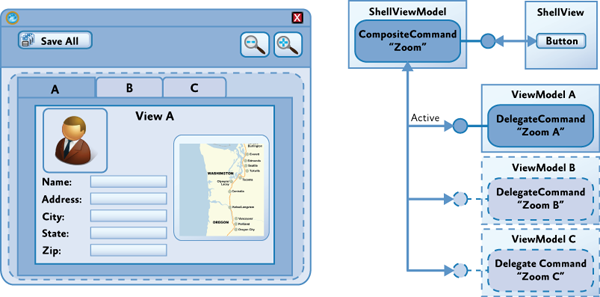Composite Commands
In many cases, a command defined by a view model will be bound to controls in the associated view so that the user can directly invoke the command from within the view. However, in some cases, you may want to be able to invoke commands on one or more view models from a control in a parent view in the application's UI.
For example, if your application allows the user to edit multiple items at the same time, you may want to allow the user to save all the items using a single command represented by a button in the application's toolbar or ribbon. In this case, the Save All command will invoke each of the Save commands implemented by the view model instance for each item as shown in the following illustration.

Prism supports this scenario through the CompositeCommand class.
The CompositeCommand class represents a command that is composed from multiple child commands. When the composite command is invoked, each of its child commands is invoked in turn. It is useful in situations where you need to represent a group of commands as a single command in the UI or where you want to invoke multiple commands to implement a logical command.
The CompositeCommand class maintains a list of child commands (DelegateCommand instances). The Execute method of the CompositeCommand class simply calls the Execute method on each of the child commands in turn. The CanExecute method similarly calls the CanExecute method of each child command, but if any of the child commands cannot be executed, the CanExecute method will return false. In other words, by default, a CompositeCommand can only be executed when all the child commands can be executed.
Note
CompositeCommand can be found in the Prism.Commands namespace which is located in the Prism.Core NuGet package.
Creating a Composite Command
To create a composite command, instantiate a CompositeCommand instance and then expose it as either an ICommand or ComponsiteCommand property.
public class ApplicationCommands
{
private CompositeCommand _saveCommand = new CompositeCommand();
public CompositeCommand SaveCommand
{
get { return _saveCommand; }
}
}
Making a CompositeCommand Globally Available
Typically, CompositeCommands are shared throughout an application and need to be made available globally. It's important that when you register a child command with a CompositeCommand that you are using the same instance of the CompositeCommand throughout the application. This requires the CompositeCommand to be defined as a singleton in your application. This can be done by either using dependency injection (DI), or by defining your CompositeCommand as a static class.
Using Dependency Injection
The first step in defining your CompositeCommands is to create an interface.
public interface IApplicationCommands
{
CompositeCommand SaveCommand { get; }
}
Next, create a class that implements the interface.
public class ApplicationCommands : IApplicationCommands
{
private CompositeCommand _saveCommand = new CompositeCommand();
public CompositeCommand SaveCommand
{
get { return _saveCommand; }
}
}
Once you have defined your ApplicationCommands class, you must register it as a singleton with the container.
public partial class App : PrismApplication
{
protected override void RegisterTypes(IContainerRegistry containerRegistry)
{
containerRegistry.RegisterSingleton<IApplicationCommands, ApplicationCommands>();
}
}
Next, ask for the IApplicationCommands interface in the ViewModel constructor. Once you have an instance of the ApplicationCommands class, can now register your DelegateCommands with the appropriate CompositeCommand.
public DelegateCommand UpdateCommand { get; private set; }
public TabViewModel(IApplicationCommands applicationCommands)
{
UpdateCommand = new DelegateCommand(Update);
applicationCommands.SaveCommand.RegisterCommand(UpdateCommand);
}
Using a Static Class
Create a static class that will represent your CompositeCommands
public static class ApplicationCommands
{
public static CompositeCommand SaveCommand = new CompositeCommand();
}
In your ViewModel, associate child commands to the static ApplicationCommands class.
public DelegateCommand UpdateCommand { get; private set; }
public TabViewModel()
{
UpdateCommand = new DelegateCommand(Update);
ApplicationCommands.SaveCommand.RegisterCommand(UpdateCommand);
}
Note
To increase the maintainability and testability of your code, it is recommended that you using the dependency injection approach.
Binding to a Globally Available Command
Once you have created your CompositeCommands, you must now bind them to UI elements in order to invoke the commands.
Using Depency Injection
When using DI, you must expose the IApplicationCommands for binding to a View. In the ViewModel of the view, ask for the IApplicationCommands in the constructor and set a property of type IApplicationCommands to the instance.
public class MainWindowViewModel : BindableBase
{
private IApplicationCommands _applicationCommands;
public IApplicationCommands ApplicationCommands
{
get { return _applicationCommands; }
set { SetProperty(ref _applicationCommands, value); }
}
public MainWindowViewModel(IApplicationCommands applicationCommands)
{
ApplicationCommands = applicationCommands;
}
}
In the view, bind the button to the ApplicationCommands.SaveCommand property. The SaveCommand is a property that is defined on the ApplicationCommands class.
<Button Content="Save" Command="{Binding ApplicationCommands.SaveCommand}"/>
Using a Static Class
If you are using the static class approach, the following code example shows how to bind a button to the static ApplicationCommands class in WPF.
<Button Content="Save" Command="{x:Static local:ApplicationCommands.SaveCommand}" />
Unregister a Command
As seen in the previous examples, child commands are registered using the CompositeCommand.RegisterCommand method. However, when you no longer wish to respond to a CompositeCommand or if you are destroying the View/ViewModel for garbage collection, you should unregister the child commands with the CompositeCommand.UnregisterCommand method.
public void Destroy()
{
_applicationCommands.UnregisterCommand(UpdateCommand);
}
Important
You MUST unregister your commands from a CompositeCommand when the View/ViewModel is no longer needed (ready for GC). Otherwise you will have introduced a memory leak.
Executing Commands on Active Views
Composite commands at the parent view level will often be used to coordinate how commands at the child view level are invoked. In some cases, you will want the commands for all shown views to be executed, as in the Save All command example described earlier. In other cases, you will want the command to be executed only on the active view. In this case, the composite command will execute the child commands only on views that are deemed to be active; it will not execute the child commands on views that are not active. For example, you may want to implement a Zoom command on the application's toolbar that causes only the currently active item to be zoomed, as shown in the following diagram.

To support this scenario, Prism provides the IActiveAware interface. The IActiveAware interface defines an IsActive property that returns true when the implementer is active, and an IsActiveChanged event that is raised whenever the active state is changed.
You can implement the IActiveAware interface on views or ViewModels. It is primarily used to track the active state of a view. Whether or not a view is active is determined by the views within the specific control. For the Tab control, there is an adapter that sets the view in the currently selected tab as active, for example.
The DelegateCommand class also implements the IActiveAware interface. The CompositeCommand can be configured to evaluate the active status of child DelegateCommands (in addition to the CanExecute status) by specifying true for the monitorCommandActivity parameter in the constructor. When this parameter is set to true, the CompositeCommand class will consider each child DelegateCommand's active status when determining the return value for the CanExecute method and when executing child commands within the Execute method.
public class ApplicationCommands : IApplicationCommands
{
private CompositeCommand _saveCommand = new CompositeCommand(true);
public CompositeCommand SaveCommand
{
get { return _saveCommand; }
}
}
When the monitorCommandActivity parameter is true, the CompositeCommand class exhibits the following behavior:
CanExecute: Returnstrueonly when all active commands can be executed. Child commands that are inactive will not be considered at all.Execute: Executes all active commands. Child commands that are inactive will not be considered at all.
By implementing the IActiveAware interface on your ViewModels, you will be notified when your view becomes active or inactive. When the view's active status changes, you can update the active status of the child commands. Then, when the user invokes the composite command, the command on the active child view will be invoked.
public class TabViewModel : BindableBase, IActiveAware
{
private bool _isActive;
public bool IsActive
{
get { return _isActive; }
set
{
_isActive = value;
OnIsActiveChanged();
}
}
public event EventHandler IsActiveChanged;
public DelegateCommand UpdateCommand { get; private set; }
public TabViewModel(IApplicationCommands applicationCommands)
{
UpdateCommand = new DelegateCommand(Update);
applicationCommands.SaveCommand.RegisterCommand(UpdateCommand);
}
private void Update()
{
//implement logic
}
private void OnIsActiveChanged()
{
UpdateCommand.IsActive = IsActive; //set the command as active
IsActiveChanged?.Invoke(this, new EventArgs()); //invoke the event for all listeners
}
}